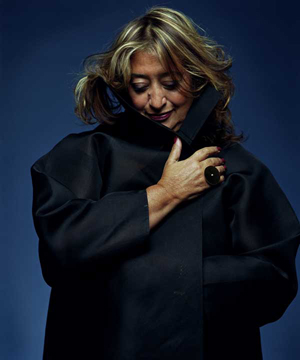Zaha Hadid là một nữ kiến trúc sư nổi tiếng người Anh gốc Iraq theo trường phái Kiến trúc giải tỏa kết cấu. Các công trình của bà mang nặng tính ý tưởng với những hình khối động và những giải pháp đặc biệt để để tiếp cận cũng như giải quyết công trình.

Bà liên tục tham gia các cuộc thi thiết kế quốc tế. Trong số đó, nổi bật có The Peak Club ở Hồng Kông năm 1983, nhà hát Opera ở vịnh Cardiff, xứ Wales (1994). Năm 1988, bà tham dự triển lãm Kiến trúc giải tỏa kết cấu ở Bảo tàng nghệ thuật Hiện đại MoMA, Thành phố New York. Năm 2002, Hadid thắng trong cuộc thi quốc tế thiết kế tổng mặt bằng Trung tâm khoa học Singapore. Năm 2004, bà là nữ kiến trúc sư đầu tiên nhận giải thưởng Pritzker. Năm 2005, bà thắng trong cuộc thi thiết kế một sòng bạc mới ở Basel (Thụy Sĩ). Không chỉ là một kiến trúc sư nổi tiếng, bà còn là một nhà thiết kế nội thất danh tiếng và nổi tiếng với tác phẩm trong nghệ thuật sắp đặt, tranh vẽ. Bà cũng được trao tặng Huân chương Đế quốc Anh, tước sĩ quan (CBE). Hiện nay, bà là thành viên của ban biên tập Bách khoa toàn thư Britannica (Encyclopædia Britannica).
Hiện bà còn là giáo sư giảng dạy nhiều đại học lớn trên thế giới, trong số đó có Trường Nghệ thuật Thị giác (Hochschule für Bildende Künste) ở Hamburg (Đức), Trường thiết kế tại Đại học Harvard, Đại học Chicago, Đại học Columbia tại Thành phố New York. Hiện bà đang giảng dạy tại Đại học Nghệ thuật ứng dụng Wien ở Áo.
Một số công trình kiến trúc nổi tiếng của Kiến trúc sư Zaha Hadid


Vòm âm nhạc Johann Sebastian Bach


Văn phòng cảng Antwerp


Nhà cầu Zaragoza


Nhà hát lớn Dubai